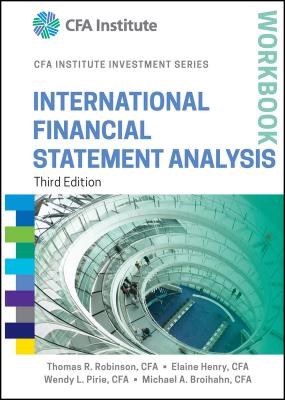ТОП просматриваемых книг сайта:
International Financial Statement Analysis Workbook. Elaine Henry
Читать онлайн.Название International Financial Statement Analysis Workbook
Год выпуска 0
isbn 9781119029724
Автор произведения Elaine Henry
Жанр Бухучет, налогообложение, аудит
Издательство John Wiley & Sons Limited
C. Balancing of qualitative characteristics.
8. The assumption that an entity will continue to operate for the foreseeable future is called:
A. accrual basis.
B. comparability.
C. going concern.
9. The assumption that the effects of transactions and other events are recognized when they occur, not when the cash flows occur, is called:
A. relevance.
B. accrual basis.
C. going concern.
10. Neutrality of information in the financial statements most closely contributes to which qualitative characteristic?
A. Relevance.
B. Understandability.
C. Faithful representation.
11. Valuing assets at the amount of cash or equivalents paid or the fair value of the consideration given to acquire them at the time of acquisition most closely describes which measurement of financial statement elements?
A. Current cost.
B. Historical cost.
C. Realizable value.
12. The valuation technique under which assets are recorded at the amount that would be received in an orderly disposal is:
A. current cost.
B. present value.
C. realizable value.
13. Which of the following is not a required financial statement according to IAS No. 1?
A. Statement of financial position.
B. Statement of changes in income.
C. Statement of comprehensive income.
14. Which of the following elements of financial statements is most closely related to measurement of performance?
A. Assets.
B. Expenses.
C. Liabilities.
15. Which of the following elements of financial statements is most closely related to measurement of financial position?
A. Equity.
B. Income.
C. Expenses.
16. Which of the following is not a characteristic of a coherent financial reporting framework?
A. Timeliness.
B. Consistency.
C. Transparency.
17. Which of the following is not a recognized approach to standard-setting?
A. A rules-based approach.
B. An asset/liability approach.
C. A principles-based approach.
18. Which of the following disclosures regarding new accounting standards provides the most meaningful information to an analyst?
A. The impact of adoption is discussed.
B. The standard will have no material impact.
C. Management is still evaluating the impact.
CHAPTER 4
UNDERSTANDING INCOME STATEMENTS
LEARNING OUTCOMES
After completing this chapter, you will be able to do the following:
● describe the components of the income statement and alternative presentation formats of that statement;
● describe general principles of revenue recognition and accrual accounting, specific revenue recognition applications (including accounting for long-term contracts, installment sales, barter transactions, gross and net reporting of revenue), and implications of revenue recognition principles for financial analysis;
● calculate revenue given information that might influence the choice of revenue recognition method;
● describe general principles of expense recognition, specific expense recognition applications, and implications of expense recognition choices for financial analysis;
● describe the financial reporting treatment and analysis of non-recurring items (including discontinued operations, extraordinary items, unusual or infrequent items) and changes in accounting standards;
● distinguish between the operating and non-operating components of the income statement;
● describe how earnings per share is calculated and calculate and interpret a company's earnings per share (both basic and diluted earnings per share) for both simple and complex capital structures;
● distinguish between dilutive and antidilutive securities, and describe the implications of each for the earnings per share calculation;
● convert income statements to common-size income statements;
● evaluate a company's financial performance using common-size income statements and financial ratios based on the income statement;
● describe, calculate, and interpret comprehensive income;
● describe other comprehensive income, and identify major types of items included in it.
SUMMARY OVERVIEW
● The income statement presents revenue, expenses, and net income.
● The components of the income statement include: revenue; cost of sales; sales, general, and administrative expenses; other operating expenses; non-operating income and expenses; gains and losses; non-recurring items; net income; and EPS.
● An income statement that presents a subtotal for gross profit (revenue minus cost of goods sold) is said to be presented in a multi-step format. One that does not present this subtotal is said to be presented in a single-step format.
● Revenue is recognized in the period it is earned, which may or may not be in the same period as the related cash collection. Recognition of revenue when earned is a fundamental principal of accrual accounting.
● In limited circumstances, specific revenue recognition methods may be applicable, including percentage of completion, completed contract, installment sales, and cost recovery.
● An analyst should identify differences in companies' revenue recognition methods and adjust reported revenue where possible to facilitate comparability. Where the available information does not permit adjustment, an analyst can characterize the revenue recognition as more or less conservative and thus qualitatively assess how differences in policies might affect financial ratios and judgments about profitability.
● The general principles of expense recognition include a process to match expenses either to revenue (such as, cost of goods sold) or to the time period in which the expenditure occurs (period costs such as, administrative salaries) or to the time period of expected benefits of the expenditures (such as, depreciation).
● In expense recognition, choice of method (i.e., depreciation method and inventory cost method), as well as estimates (i.e., uncollectible accounts, warranty expenses, assets' useful life, and salvage value) affect a company's reported income. An analyst should identify differences in companies' expense recognition methods and adjust reported financial statements where possible to facilitate comparability. Where the available information does not permit adjustment, an analyst can characterize the policies and estimates as more or less conservative and thus qualitatively assess how differences in policies might affect financial ratios and judgments about companies' performance.
● To assess a company's future earnings, it is helpful to separate those prior years' items of income and expense that are likely to continue in the future from those items that are less likely to continue.
● Under IFRS, a

